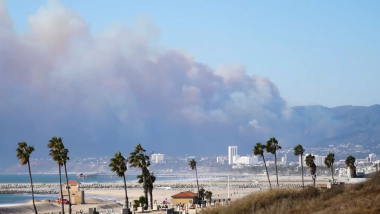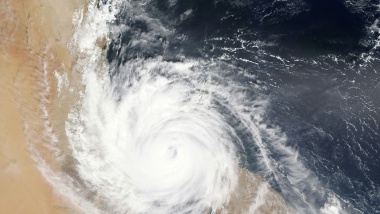COP28: Key messages and implications for insurers
By Maryam Golnaraghi
Director Climate Change and Environment
The 28th United Nations Framework Convention on Climate Change (UNFCCC) Conference of the Parties (COP28) was held from 30 November to 13 December 2023 in Dubai, United Arab Emirates (UAE). In addition to national delegations from nearly 200 countries, this event brought together a record number of participants (nearly 85,000) from business, civil society (indigenous peoples, youth, philanthropy), and international organisations to share ideas, solutions, and build partnerships and coalitions.1 The event achieved a number of important ‘firsts’ since the launch of UNFCCC COP discussions nearly three decades ago.
This article offers four key takeaways from COP28 and their implications for insurance and reinsurance companies (re/insurers).
1. For the first time at a COP, the final negotiated framework agreement referred to as “The UAE Consensus,” explicitly calls for ‘transitioning away from fossil fuels’.2 In addition, it lays out milestones for the expansion of renewables, achieving energy efficiency, expediting new climate technologies for industrial decarbonisation and curbing methane emissions in the oil and gas sector. Importantly, under the same paragraph, the agreement calls for:
- Tripling renewable energy capacity, globally, and doubling the global average annual rate of energy efficiency investments by 2030.
- Accelerating climate technologies, such as carbon capture and storage; low-carbon hydrogen production
- Substantially reducing non-carbon-dioxide emission, particularly methane (also mentioned for the first time in negotiated COP documents), with 50 oil companies, representing nearly half of global production, pledging to reach near-zero methane emissions and end routine flaring in their operations by 2030.
What does this mean for re/insurers?
While the language on transitioning away from fossil fuels leaves many loopholes, there is for the first time a formal recognition by governments of fossil fuels as the primary cause of anthropogenic climate change and the need for the global economy to transition away from fossil fuels. This will have implications for how insurers will balance the phasing out of fossil fuels and phasing in of climate tech for energy transition and transform their underwriting and investment portfolios.
Re/insurers already offer a wide range of insurance products and services for as well as invest in renewables and energy efficiency solutions. Several factors have held back solar and wind power (onshore and offshore) from realising their full deployment potential, such as the policy and regulatory environment, excessive permitting timelines, supply chain issues, and high political, credit and currency risks in some countries. While COP28 targets of tripling renewables and doubling energy efficiency until 2030 offer major growth potential for insurance markets and investments in both developed and developing economies, the insurance industry can also raise awareness about the issues that need to be addressed to enable development in these sectors.
Accelerating new technologies such as green hydrogen and carbon removal and storage, presents re/insurers with many opportunities, but realising these requires new ways of doing business. Two forthcoming Geneva Association reports will provide insights and guidance on challenges, opportunities, and how re/insurers can engage with other stakeholders to help expedite the commercialisation of climate technologies.3
2. COP28 adopted a plan for the operationalisation of the new Loss and Damage Fund which was launched at COP27. The World Bank will host the Fund and serve as its trustee for the first four years.4
The fund received pledges of just over USD 700 million to start assisting developing countries that are particularly vulnerable to the adverse effects of climate change. Operationalising the Fund, receiving the pledges from governments and translating them into meaningful projects on the ground will take time.
What does this mean for re/insurers?
Overtime, as the funds become available, they can be leveraged with other funding sources to implement meaningful adaptation and disaster risk reduction projects and tackle the rising protection gap against extreme events in the most vulnerable countries. Platforms such as the Insurance Development Forum (IDF) and the Global Shield against Climate Risks, engaging re/insurers, United Nations, multi-lateral banks and international development agencies, are already working to educate governments about the benefits of insurance and working on solutions for the most vulnerable nations.5,6 Re/insurers could engage through these platforms with governments and local actors to develop proposals to be submitted to the Loss and Damage Fund to launch or expand insurance solutions in these nations.
3. At the “Reaching the Last Mile Forum,” the first-ever COP event on the topic of climate change and health, global donors pledged over US 777 million to tackle neglected tropical diseases (NTD) and improve the lives of 1.6 billion people.
With the participation of philanthropic organisations such as the Bill & Melinda Gates Foundation, these efforts aim to prioritise funding for life-saving healthcare – particularly among poor communities around the world – and eliminate two NTDs from the continent of Africa.
What does this mean for re/insurers?
While there have been significant investments in research on the impacts of climate change on health, it remains fragmented and lacks a focus on the “so what?” from life and health insurance perspectives. The new global dialogue on the COP’s stage offers an opportunity to bring focus to the role of the sector and the benefits of availability and accessibility of insurance services, particularly in light of rising mortality and morbidity risks due to climate change. Life and health insurers can engage in this process to raise awareness and promote the need for more coordinated research through cross-sectoral partnerships to support the development of public policies, data and risk assessment tools and risk management measures that could lead to the expansion of insurance for the most vulnerable populations.
As a starting point, an overview of climate change risks related to mortality, morbidity and longevity and the implications for life and health re/insurers will be offered in a forthcoming Geneva Association report.
4. The need for a cohesive global carbon market architecture and reliable carbon credits for effective climate mitigation was discussed, but actions are delayed to next year.
Carbon-pricing schemes – both compliance markets and high integrity voluntary carbon markets (VCMs) – which channel finance to high-quality decarbonisation projects, play a critical role in the global net-zero transition, especially in emerging markets. However, over the last year the quality of carbon credits for nature-based solutions and their verification has come under scrutiny. Carbon credit markets for technological solutions, such as geological and in-situ mineralisation, are also being considered, but there a number of hurdles.
What does this mean for re/insurers?
The development of more robust standards for certification, monitoring, verification and reporting could create opportunities for insurers to offer solutions to cover project risks, related carbon credit forecasts, and the quality of carbon credits (in both voluntary and compliance carbon markets). The development of robust carbon markets also offers an incentive to scale up carbon removal and storage projects, with opportunities to offer insurance solutions and invest. However, a major hurdle to the development of such projects is the long-term carbon reversal risk (e.g. what if Co2 escapes in 20-30 years), which needs to be addressed.
1 https://unfccc.int/news/cop28-agreement-signals-beginning-of-the-end-of-the-fossil-fuel-era#:~:text=World%20leaders%20at%20COP28%20were,and%20build%20partnerships%20and%20coalitions
2 United Nations. Outcome of first global stocktake, paragraph 28. 13 December 2023. https://unfccc.int/documents/636608
3 https://www.epa.gov/natural-gas-star-program/methane-mitigation-technologies-platform
4 https://www.globalshield.org/news/global-shield-gains-more-momentum-at-cop28/#:~:text=2%20December%202023%2C%20DUBAI%20%E2%80%93%20The,Global%20Shield%20against%20Climate%20Risks%E2%80%9D
5 https://www.globalshield.org/news/global-shield-gains-more-momentum-at-cop28/#:~:text=2%20December%202023%2C%20DUBAI%20%E2%80%93%20The,Global%20Shield%20against%20Climate%20Risks%E2%80%9D
6 Golnaraghi, M. COP27: Key messages and implications for insurers. 15 December 2022. https://www.genevaassociation.org/publication/climate-change-and-environment/cop27-key-messages-and-implications-insurers






